Streets of New Capenna is fascinating in its choice and implementation of faction mechanics. Two of its mechanics are fairly straightforward: shield counters are powerful yet wonderfully simple (though a bit awkward in a set that also uses +1/+1 counters and lacks punch-out counters), as is Alliance (though it imposes potentially homogenizing deckbuilding constraints). The other three, however, are quite Spike-y. Connive is a twist on Explore that reduces variance and power in exchange for increased agency. Blitz is Dash where you draw a card instead of getting your creature back. Casualty is vaguely akin to Conspire, but instead of temporarily losing two creatures, you permanently lose one.
Now, there’s nothing inherently wrong with having a plurality of Spike-friendly mechanics as long as there’s plenty for non-Spikes to enjoy. But I’ve been finding Casualty especially hard to evaluate. So today, we’re going to run the gamut of Casualty cards to try and guess at how the mechanic will function.
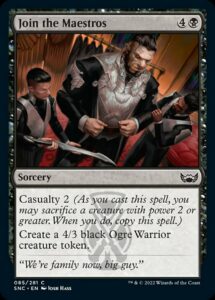
Join the Maestros is clear in how it’s intended to be used. For five mana, you can either drastically overpay for an undervalued creature or do that and make up the difference by upgrading a 2/1 or 2/2 (or a creature under Witness Protection) into a 4/3. Whenever this opportunity presents itself, you should always pay the additional cost. Sure, you’re giving up some amount of board presence, but you immediately receive a rebate in the form superior board presence.
I like how clear this design’s intended use is—sure, there’s plenty of lenticular design hiding among all the cards of Streets of New Capenna and battlefield situations, but it’s easy to see how Casualty can pay you off without really costing you anything.
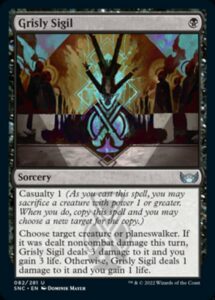
Grisly Sigil is a bit more complicated, but as with Join the Maestros, it finds a way to compensate you for your lost board presence. The baseline use case is a cross between Bone Splinters and Vampiric Feast. You go down a card and a small creature, but your opponent loses a better creature and you gain a cushion of 4 life. That’s not a terrible deal, especially in a set with both sacrifice fodder and rewards for filling your graveyard.
The design is a little awkward in that I expect some players to miss the crucial “noncreature damage” element and expect this to be a Fatal Blow, but besides that, I’m on board. As with Join the Maestros, the Casualty cost is a major aspect of the card—you put this into your deck expecting to use it the majority of the time, and the effect helps offset the loss of tempo Casualty imposes.
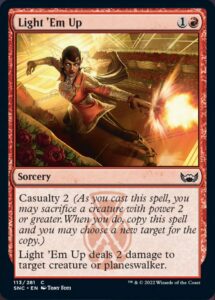
The sweetly named Light ‘Em Up is simpler than Grisly Sigil (and also synergizes with it). On its own, it’s a begrdugingly playable Shock variant. Alternatively, it’s a Furious Reprisal/Flame Lash that requires a fair bit of effort to feel like you’ve gotten ahead of your opponent. The increase in cost from Casualty 1 to Casualty 2 likely has a big impact on how easy it’ll be to be satisfied by your exchange. Still, it doesn’t feel too hard to figure out what this card is capable of and how it’s intended to be used.
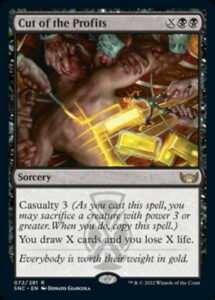
Cut of the Profits, on the other hand, I find absolutely baffling. Damnable Pact was never a strong card—it’s dangerous enough to sink 6+ mana into a sorcery-speed spell that doesn’t impact the battlefield, but it’s suicide to do that and lose life. Damnable Pact functioned because it could be a bad draw spell or a means of killing your opponent via damage or milling, but Cut of the Profits doesn’t have that modality. I can understand this as a Commander card, but have a hard time imagining it’ll go well for you if you loudly signal to the table that you are both vulnerable and about to get up to some serious tomfoolery next turn.
Here, Casualty takes the downside of Damnable Pact and magnifies it. Doubling your self-damage doubles your vulnerability in addition to your increased vulnerability from sacrificing a midsized creature. Sure, Casualty 3 means you can spend less mana and actually play something you draw, but it feels like getting the exact math right is going to be fun for only a small subset of players. I just don’t get this play pattern. Sure, it’s sweet to generate more value from your spell and can be fun to sacrifice creatures, but spending this much mana and tempo on an effect feels dangerous.
Game designers shouldn’t often give players loaded shotguns pointed at their feet and dare them to pull the trigger, and cards like Cut of the Profits, Illicit Shipment, and Cut Your Losses all feel like they do that. They’re expensive, not strong on their own, don’t affect the battlefield, and are liable to kill you if you pay their hefty Casualty costs (unless you were already winning, in which case they’re doing little to help).
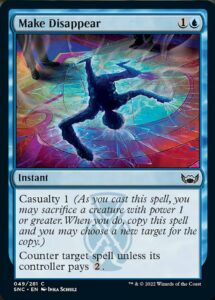
I find Make Disappear confusing, but purely out of how unexciting I find it. Unlike Join the Maestros, Grisly Sigil, and Light ‘Em Up, Make Disappear‘s default use seems to be ignoring Casualty. Sure, Quench isn’t especially good and upgrading it to Convolute stands a good chance of Canceling your opponent’s play, but going down a card is a serious cost. I like how this theoretically serves as a countermeasure to Casualty, but unless you’re countering both the spell and its copy, you’re still behind. I just don’t understand why this exists.
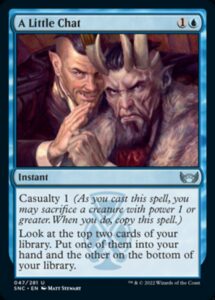
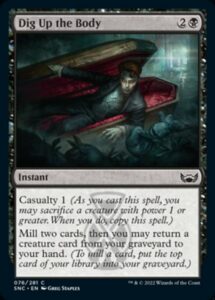
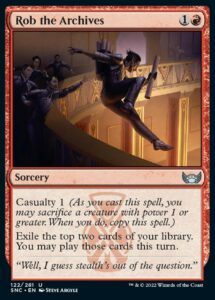
These three spells feel like they hit a sweet spot. At Casualty 1 and two mana, you can likely afford to trade a bit of tempo for card advantage. But you’re still getting a perfectly fine effect if you don’t sacrifice a creature. I like how they don’t provide an obvious option, but both choices work well. I like how the instants effectively let you play with Altar’s Reap without forcing you to sacrifice a creature. It does feel a little weird to have three spells doing such similar things, but the numbers do feel especially good here. Perhaps the mechanic simply doesn’t have that many configurations that yield such interesting choices?
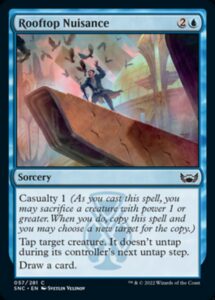
Finally, there’s Rooftop Nuisance, the progenitor of this article. On its own, it’s Crippling Chill, a serviceable but often unexciting spell with room to grow (see Chill of the Grave and Glacial Grasp). However, Casualty can turn it into both a Frost Breath and a Divination, two spells which pull in very different directions and neither of which loves sacrificing board presence. Frost Breath is normally an aggressive card, and aggressive deck tend not to love sacrificing their attack creatures. Other times, Frost Breath is a desperate tool for control decks to buy time and they absolutely can’t afford to sacrifice board presence. And, as discussed with Cut of the Profits, durdling with card draw while sacrificing board presence is dangerous.
However, I know that past precedent can only be so helpful in evaluating new cards. We’ve simply never seen many blue Aristocrats-style archetypes, so cards like Rooftop Nuisance haven’t had natural homes. With Streets of New Capenna, they now do. I think much of the fun of drafting the Maestros will be figuring out how Rooftop Nuisance works best. How often are you supposed to sacrifice a card? If it’s generally better as Crippling Chill, is it good enough?
If Casualty is more often the right choice, what kinds of decks will want this most? This is an area where I don’t have the answers, but I have a lot of questions and I know the fun will be in the answering. I’m just a bit surprised that I don’t feel that way about any other Casualty cards, but that could all be the fault of faulty assumptions on my part. In any case, I’m excited to see how it plays and hope you all get a chance to enjoy it, either in paper this weekend or digitally next week. And if you should open an Ob Nixilis, the Adversary, you should definitely give him a friend—there’s no question whether two planeswalkers are better than one.
Zachary Barash is a New York City-based game designer and the last commissioner of Team Draft League. He designs for Kingdom Death: Monster, has a Game Design MFA from the NYU Game Center, and does freelance game design. When the stars align, he streams Magic (but the stars align way less often than he’d like).

